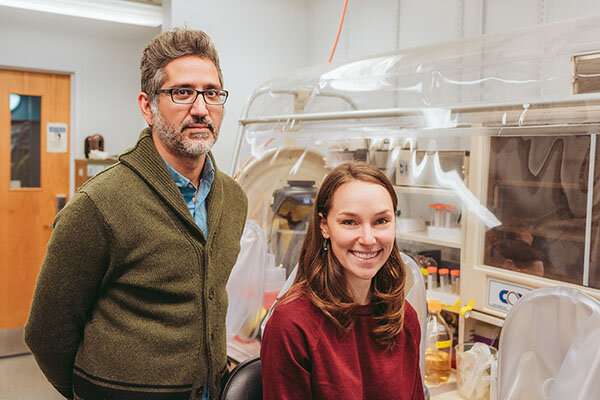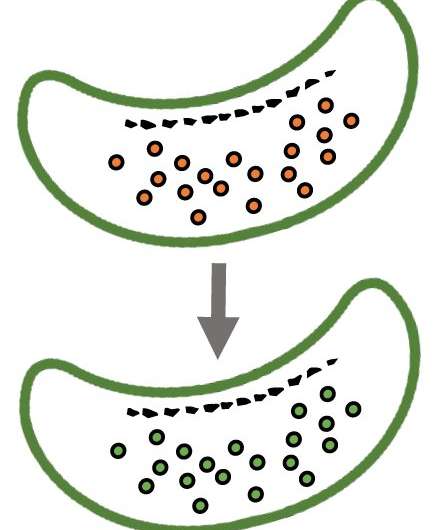Arash Komeili and Bakar Innovation Fellow Carly Grant study the magnetic properties of unusual aquatic bacteria that store dissolved iron and use it to navigate along the earth’s magnetic field. Credit: Mark Joseph Hanson
They're microscopic miners. Some species of aquatic bacteria draw in dissolved iron from their watery environment and store it in specialized compartments called magnetosomes. They use its magnetic properties to navigate, sort of like ancient mariners using a lodestone to keep their bearings.
The bacteria thrive near the bottom of bodies of water, where oxygen levels tend to be lowest. They migrate down to the low-oxygen zones using their stash of iron like train wheels, traveling along the tracks of the earth's magnetic field.
Arash Komeili, Professor of Plant and Microbial Biology and one of this year's Bakar Fellows, aims to understand what controls and maintains the microbes' novel traits. But a recent discovery may also lead to new ways to extract metals for commercial value or environmental cleanup. He described his research and the discovery that has led him in a new direction.
Q. How long have scientists known about these iron-mining bacteria?
A. They were discovered in the mid 1960s, and then essentially rediscovered about ten years later. But how the bacteria actually carry out this process has not been well studied. Over the last 25 years, researchers have determined that 20 to 30 genes are involved in the transport of iron, converting it to magnetite and storing in within the magnetosomes' membranes.
Q. How does the magnetite actually orient the bacteria?
A. Each magnetosome creates as many as 20 magnetite crystals that form a chain, and this acts like a compass needle to orient the bacteria in geomagnetic fields.
Q. This seems like such an esoteric trait. How widespread is it?
A. It's unclear. Maybe about 30 species have been identified that contain magnetosomes. Recently, we discovered that there is a second type of iron-containing compartment in some of these bacteria. Initially we thought they were simpler precursors to magnetosomes, carrying out just the first steps of the process.
Re-engineering ferrosomes: Understanding the genetic controls of iron transport in one of two types of bacterial compartments may allow scientists to concentrate iron or other metals and extract them with magnets. Credit: Arash Komeili
Then came the big surprise. This second kind of compartment contains iron, but it's not converted into magnetite. It's not magnetic at all. The iron has nothing to do with navigation. The storage is probably an adaptation to avoid iron starvation. And the iron is transported and stored in a much different way in these compartments.
Q. It sounds kind of like storing up fat for a lean winter. How did you discover this?
A. Meghan Byrne, a former postdoc in the lab, injected dissolved iron into the bacteria that contain magnetosomes and then tracked where the iron ended up. We naturally expected it would be stored in the magnetosome. But we found it in these distinctly different kinds of compartment that we call ferrosomes.
Then Carly Grant, a current postdoc, determined that only three to six genes are involved in iron transport and storage in ferrosomes, making them a much simpler system than magnetosomes.
Q. Where do you think this discovery might lead?
A. We want to gain a better understanding of this process. The Bakar Fellows funding will support more research on the protein transporters that ferry metal into the ferrosomes. Since only a few genes are involved, it will be much simpler to manipulate the genes to tease apart ferrosome transport and storage.
Q. How could this fuller understanding be applied?
A. We should be able to optimize the ferrosome size and number in the cell, and modify the bacteria so that ferrosomes are present at all times when magnetosomes are being made. Modifying the types of genes for ferrosome metal transport and when they are expressed should allow us to concentrate new metals of interest like gold, copper or manganese.
The mined metals in the engineered ferrosomes would be present in the same cells as the magnetic particles of magnetosomes, and because the magnetosomes are magnetic, the accumulated metals could then be extracted by magnets.
The genetic control could make for a kind of "plug and play" method to extract specific metals. The ability to concentrate different metals could be used to access valuable elements or to clear toxic metals from polluted water. This will require more research in the lab but it should be doable.
Provided by University of California - Berkeley
























